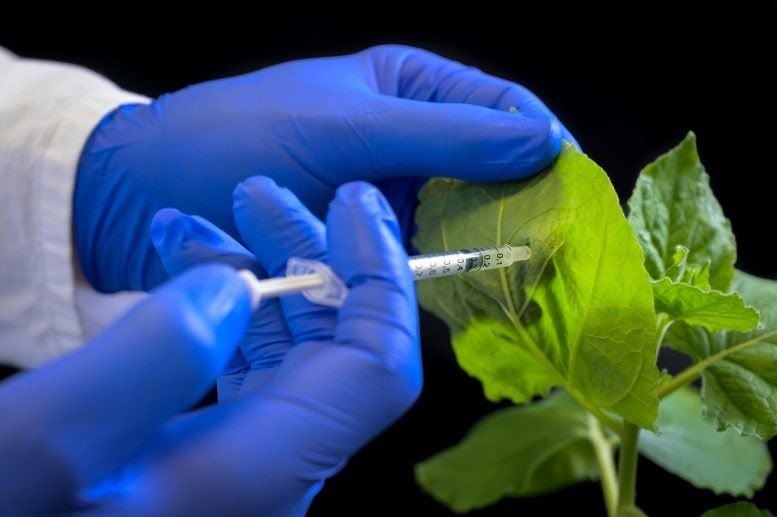Scientists Reveal Revolutionary RNA Shield to Protect Crops from Viruses
Challenges of the Cucumber Mosaic Virus
Cucumber Mosaic Virus (CMV) is a highly destructive pathogen affecting over 1,200 plant species, including vital crops such as squash, cucumbers, cereals, and medicinal plants. It spreads swiftly through nearly 90 species of aphids and is identifiable by the characteristic mosaic-like discoloration on infected leaves. Once infected, plants experience stunted growth, and their fruit becomes unmarketable.

Figure 1. Breakthrough RNA Shield Protects Crops from Viruses.
Currently, no approved treatments exist for CMV. However, researchers at MLU are working to change this by enhancing the plant’s natural defense mechanisms, helping them more effectively combat the virus. Figure 1 shows Breakthrough RNA Shield Protects Crops from Viruses.
The Role of siRNA in Plant Immunity
When a virus infects a plant, it hijacks the plant’s cells, using them to replicate its genetic material in the form of ribonucleic acid (RNA) molecules. In response, the plant’s immune system detects these foreign RNA molecules and activates a defense mechanism. Specialized enzymes act like molecular scissors, recognizing and cutting the viral RNA.
This process generates small interfering RNAs (siRNAs), which spread throughout the plant and initiate a secondary immune response. These siRNA molecules bind to specific protein complexes, guiding them to target and degrade the viral RNA. As a result, the virus's harmful RNA is broken down into harmless fragments, preventing further infection.
Enhancing Plant Defense with edsRNA
“The natural defense process is often inefficient. While a viral infection generates many siRNA molecules, only a few provide effective protection,” explains Professor Sven-Erik Behrens from the Institute of Biochemistry and Biotechnology at MLU.
To address this, his team developed a method to identify the most efficient siRNA molecules. Taking this a step further, they successfully combined several of these highly effective molecules into specialized double-stranded RNA structures known as efficient double-stranded RNAs (edsRNAs), which are particularly well-suited for plant use.
Once inside plant cells, these edsRNAs quickly break down into protective siRNA molecules, enabling a strong and immediate antiviral response to safeguard the plant.
Effective Protection in Lab Conditions
The research team conducted extensive laboratory tests on the model plant Nicotiana benthamiana and demonstrated that edsRNA-based treatments effectively protect against the Cucumber Mosaic Virus (CMV).
“The plants in our experiments were exposed to an extremely high viral load—every untreated plant died,” says Professor Behrens. In contrast, 80 to 100 percent of the treated plants survived. A key advantage of edsRNA agents is their ability to break down into multiple highly efficient siRNA molecules, which attack the virus at different sites, significantly enhancing the protective effect.
RNA viruses like CMV pose a major threat because they evolve rapidly. CMV’s genetic material consists of three separate segments, which can recombine, increasing the likelihood of new mutations. “To maximize protection, our active agents target multiple parts of the virus’s genome,” Behrens explains.
Additionally, the team has optimized the process for identifying effective siRNAs, allowing them to adapt treatments to new viral mutations within just two to four weeks. “Speed is crucial. When a new virus variant emerges, we can rapidly adjust the active agent,” Behrens adds. This innovative approach may also be applicable to other plant pathogens and pests.
Future Directions and Commercialization
Currently, the RNA-based substances are applied manually in the lab, either by injection or by rubbing them onto plant leaves. To make the treatment more practical for large-scale use, the team is collaborating with Professor Karsten Mäder, a specialist in pharmaceutical drug delivery at MLU. Their goal is to develop more stable formulations that can be easily applied, such as through spraying.
The next step involves field trials to evaluate the effectiveness of the RNA-based agents under real agricultural conditions. Additionally, discussions with industry partners are underway to explore large-scale production. However, before these crop protection products can reach the market, they must undergo a regulatory approval process, which may take time.
“Despite these challenges, we are confident in the feasibility of our approach,” says Behrens. “The first crop protection product with an RNA-based active ingredient was recently approved in the USA, demonstrating the potential of this technology.”
Source: SciTECHDaily
Cite this article:
Priyadharshini S (2025),”Scientists Reveal Revolutionary RNA Shield to Protect Crops from Viruses", AnaTechmaz, pp.1112

